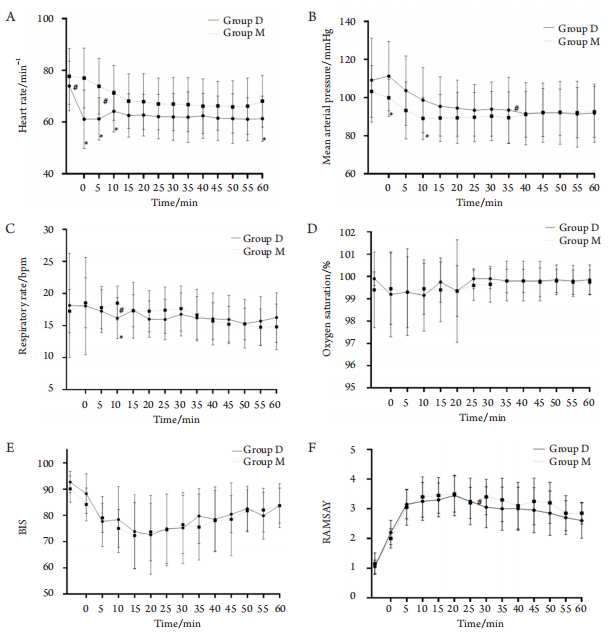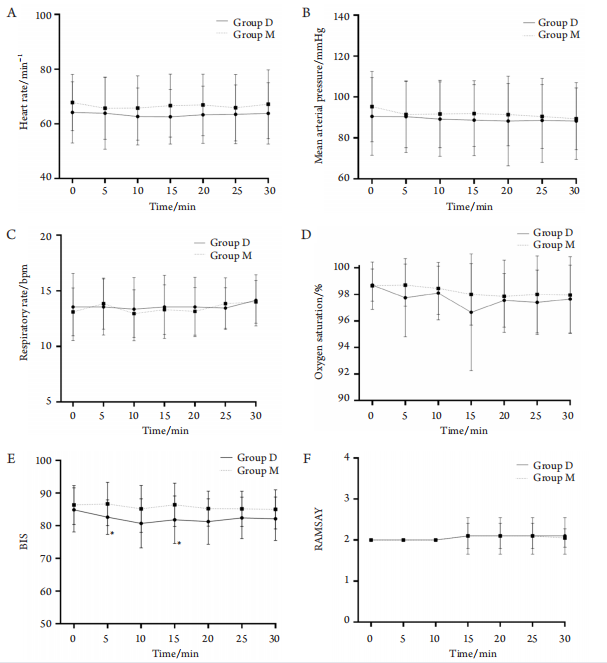1、Dhaliwal A, Dhindsa BS, Saghir SM, et al. Choice of sedation in endoscopic retrograde cholangiopancreatography: is monitored anesthesia care as safe as general anesthesia? A systematic review and meta-analysis[ J]. Ann Gastroenterol, 2021, 34(6): 879-887.Dhaliwal A, Dhindsa BS, Saghir SM, et al. Choice of sedation in endoscopic retrograde cholangiopancreatography: is monitored anesthesia care as safe as general anesthesia? A systematic review and meta-analysis[ J]. Ann Gastroenterol, 2021, 34(6): 879-887.
2、Kim S, Chang BA, Rahman A, et al. Analysis of urgent/emergent conversions from monitored anesthesia care to general anesthesia with airway instrumentation[ J]. BMC Anesthesiol, 2021, 21(1): 183.Kim S, Chang BA, Rahman A, et al. Analysis of urgent/emergent conversions from monitored anesthesia care to general anesthesia with airway instrumentation[ J]. BMC Anesthesiol, 2021, 21(1): 183.
3、McHugh TA . Implications of inspired carbon dioxide during ophthalmic surgery performed using monitored anesthesia care[ J]. AANA J, 2019, 87(4): 285-290.McHugh TA . Implications of inspired carbon dioxide during ophthalmic surgery performed using monitored anesthesia care[ J]. AANA J, 2019, 87(4): 285-290.
4、Kumar CM, Chua AWY, Imani F, et al. Practical considerations for dexmedetomidine sedation in adult cataract surgery under local/ regional anesthesia: a narrative review[ J]. Anesth Pain Med, 2021, 11(4): e118271.Kumar CM, Chua AWY, Imani F, et al. Practical considerations for dexmedetomidine sedation in adult cataract surgery under local/ regional anesthesia: a narrative review[ J]. Anesth Pain Med, 2021, 11(4): e118271.
5、 Hu J, Lv B, West R, et al. Comparison between dexmedetomidine and propofol on outcomes after coronary artery bypass graft surgery: a retrospective study[ J]. BMC Anesthesiol, 2022, 22(1): 51. Hu J, Lv B, West R, et al. Comparison between dexmedetomidine and propofol on outcomes after coronary artery bypass graft surgery: a retrospective study[ J]. BMC Anesthesiol, 2022, 22(1): 51.
6、Jones JH, Aldwinckle R. Perioperative dexmedetomidine for outpatient cataract surgery: a systematic review[ J]. BMC Anesthesiol, 2020, 20(1): 75.Jones JH, Aldwinckle R. Perioperative dexmedetomidine for outpatient cataract surgery: a systematic review[ J]. BMC Anesthesiol, 2020, 20(1): 75.
7、Hamid M, Shiwani HA, Hamid F. A survey of anaesthetic preferences in cataract surgery[ J]. Int J Ophthalmol, 2022, 15(2): 342-345.Hamid M, Shiwani HA, Hamid F. A survey of anaesthetic preferences in cataract surgery[ J]. Int J Ophthalmol, 2022, 15(2): 342-345.
8、Stasiowski MJ, Pluta A, Lyssek-Boroń A, et al. Adverse events during vitreoretinal surgery under adequacy of anesthesia guidance-risk factor analysis[ J]. Pharmaceuticals (Basel), 2022, 15(2): 237.Stasiowski MJ, Pluta A, Lyssek-Boroń A, et al. Adverse events during vitreoretinal surgery under adequacy of anesthesia guidance-risk factor analysis[ J]. Pharmaceuticals (Basel), 2022, 15(2): 237.
9、李玉梅, 黄丽娟, 邓勇惠, 等. 2182例白内障复明手术术前的焦虑情况[ J]. 眼科学报, 2018, 33(1): 10-14.
LI Yumei, HUANG Lijuan, DENG Yonghui, et al. Preoperative anxiety in 2182 cataract surgeries[ J]. Yan Ke Xue Bao, 2018, 33(1): 10-14.李玉梅, 黄丽娟, 邓勇惠, 等. 2182例白内障复明手术术前的焦虑情况[ J]. 眼科学报, 2018, 33(1): 10-14.
LI Yumei, HUANG Lijuan, DENG Yonghui, et al. Preoperative anxiety in 2182 cataract surgeries[ J]. Yan Ke Xue Bao, 2018, 33(1): 10-14.
10、Li S, Liu T, Xia J, et al. Effect of dexmedetomidine on prevention of postoperative nausea and vomiting in pediatric strabismus surgery: a randomized controlled study[ J]. BMC Ophthalmol, 2020, 20(1): 86.Li S, Liu T, Xia J, et al. Effect of dexmedetomidine on prevention of postoperative nausea and vomiting in pediatric strabismus surgery: a randomized controlled study[ J]. BMC Ophthalmol, 2020, 20(1): 86.
11、Song J, Liu S, Fan B, et al. Perioperative dexmedetomidine reduces emergence agitation without increasing the oculocardiac reflex in children: A systematic review and meta-analysis[ J]. Medicine (Baltimore), 2021, 100(18): e25717.Song J, Liu S, Fan B, et al. Perioperative dexmedetomidine reduces emergence agitation without increasing the oculocardiac reflex in children: A systematic review and meta-analysis[ J]. Medicine (Baltimore), 2021, 100(18): e25717.
12、Jabalameli M, Nazemroaya B, Heydari M. Comparative study of the prophylactic effects of intravenous injection of dexmedetomidine, ondansetron, and pethidine on postoperative shivering of abdominal surgery under general anesthesia: a randomized clinical trial[ J]. Adv Biomed Res, 2021, 10: 45.Jabalameli M, Nazemroaya B, Heydari M. Comparative study of the prophylactic effects of intravenous injection of dexmedetomidine, ondansetron, and pethidine on postoperative shivering of abdominal surgery under general anesthesia: a randomized clinical trial[ J]. Adv Biomed Res, 2021, 10: 45.
13、Fannon S, Kisting MA, Anderson C. Implementation of a protocol: dexmedetomidine for use in long-term procedural sedation in non-intubated pediatric patients[ J]. J Pediatr Nurs, 2021, 58: 39-43.Fannon S, Kisting MA, Anderson C. Implementation of a protocol: dexmedetomidine for use in long-term procedural sedation in non-intubated pediatric patients[ J]. J Pediatr Nurs, 2021, 58: 39-43.
14、Uusalo P, Sepp?nen SM, J?rvisalo MJ. Feasibility of intranasal dexmedetomidine in treatment of postoperative restlessness, agitation, and pain in geriatric orthopedic patients[ J]. Drugs Aging, 2021, 38(5): 441-450.Uusalo P, Sepp?nen SM, J?rvisalo MJ. Feasibility of intranasal dexmedetomidine in treatment of postoperative restlessness, agitation, and pain in geriatric orthopedic patients[ J]. Drugs Aging, 2021, 38(5): 441-450.
15、Fiorelli S, Creazzola F, Massullo D, et al. Dexmedetomidine sedation after tracheal surgery: a prospective pilot study[ J]. Ann Thorac Surg, 2019, 108(1): 256-261.Fiorelli S, Creazzola F, Massullo D, et al. Dexmedetomidine sedation after tracheal surgery: a prospective pilot study[ J]. Ann Thorac Surg, 2019, 108(1): 256-261.
16、Allam AA, Eleraky NE, Diab NH, et al. Development of sedative dexmedetomidine sublingual in situ gels: in vitro and in vivo evaluations[ J]. Pharmaceutics, 2022, 14(2): 220.Allam AA, Eleraky NE, Diab NH, et al. Development of sedative dexmedetomidine sublingual in situ gels: in vitro and in vivo evaluations[ J]. Pharmaceutics, 2022, 14(2): 220.
17、Fakhoury H, Abdelmassih Y, El-Khoury S, et al. Effect of topicaldexmedetomidine (0.0055%) on intraocular pressure in healthy eyes: a randomized controlled trial[ J]. J Curr Glaucoma Pract, 2021, 15(2): 58-63.Fakhoury H, Abdelmassih Y, El-Khoury S, et al. Effect of topicaldexmedetomidine (0.0055%) on intraocular pressure in healthy eyes: a randomized controlled trial[ J]. J Curr Glaucoma Pract, 2021, 15(2): 58-63.
18、Ali H, Eissa S, Magdy H, et al. Dexmedetomidine as an additive to local anesthesia for decreasing intraocular pressure in glaucoma surgery: a randomized trial[ J]. Anesth Pain Med, 2020, 10(3): e100673.Ali H, Eissa S, Magdy H, et al. Dexmedetomidine as an additive to local anesthesia for decreasing intraocular pressure in glaucoma surgery: a randomized trial[ J]. Anesth Pain Med, 2020, 10(3): e100673.
19、 Wang Q, Li H, Wei S, et al. Dexmedetomidine added to ropivacaine for ultrasound-guided erector spinae plane block prolongs analgesia duration and reduces perioperative opioid consumption after thoracotomy: a randomized, controlled clinical study[ J]. Clin J Pain, 2021, 38(1): 8-14. Wang Q, Li H, Wei S, et al. Dexmedetomidine added to ropivacaine for ultrasound-guided erector spinae plane block prolongs analgesia duration and reduces perioperative opioid consumption after thoracotomy: a randomized, controlled clinical study[ J]. Clin J Pain, 2021, 38(1): 8-14.
20、Ki S, Lee D, Lee W, et al. Verification of the performance of the Bispectral Index as a hypnotic depth indicator during dexmedetomidine sedation[ J]. Anesth Pain Med (Seoul), 2022, 17(1): 44-51.Ki S, Lee D, Lee W, et al. Verification of the performance of the Bispectral Index as a hypnotic depth indicator during dexmedetomidine sedation[ J]. Anesth Pain Med (Seoul), 2022, 17(1): 44-51.







